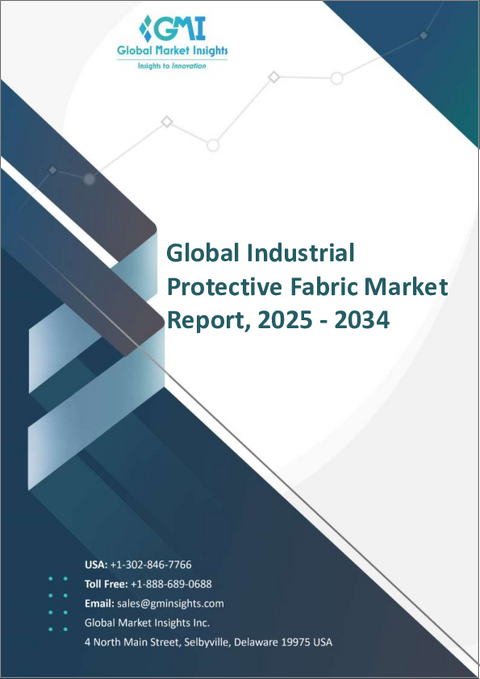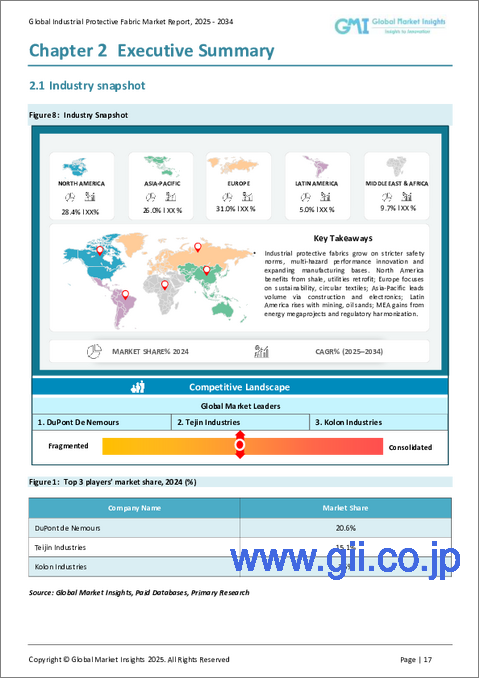|
|
市場調査レポート
商品コード
1833640
産業用防護布の市場機会、成長促進要因、産業動向分析、2025年~2034年予測Industrial Protective Fabrics Market Opportunity, Growth Drivers, Industry Trend Analysis, and Forecast 2025 - 2034 |
||||||
カスタマイズ可能
|
|||||||
| 産業用防護布の市場機会、成長促進要因、産業動向分析、2025年~2034年予測 |
|
出版日: 2025年09月10日
発行: Global Market Insights Inc.
ページ情報: 英文 192 Pages
納期: 2~3営業日
|
概要
世界の産業用防護布市場は、2024年には57億米ドルとなり、CAGR12.1%で成長し、2034年までには181億米ドルに達すると推定されています。

産業界が職場の安全性と規制遵守をより重視するようになるにつれ、こうした特殊繊維の需要は増加の一途をたどっています。火災、熱、化学物質、電気アーク、機械的摩耗などの危険から作業員を保護するために設計された防護布は、石油・ガス、建設、鉱業、公益事業部門で採用が増加しています。政府や国際機関は厳しい労働安全ガイドラインを課しており、企業は高度な保護ソリューションへの投資を余儀なくされています。同時に、従業員の安全に対する意識の高まりと、耐久性があり持続可能な素材へのニーズが、業界の需要を形成しています。多くの企業が防護繊維の製造に環境に優しいアプローチを採用する一方で、これらの生地が過酷な条件下でも回復力を維持できるようにしています。技術革新への投資と長持ちする高性能製品への注力が相まって、防護布は基本的な安全装備から、現代の職場慣行に統合された技術的に高度で持続可能なソリューションへと変貌しつつあります。
| 市場範囲 | |
|---|---|
| 開始年 | 2024年 |
| 予測年 | 2025年~2034年 |
| 市場金額 | 57億米ドル |
| 予測金額 | 181億米ドル |
| CAGR | 12.1% |
アラミド分野は2024年に32億米ドルに達し、2034年までCAGR13.2%で成長すると予測されます。アラミド繊維の強力な採用は、その優れた強度、難燃性、過酷な条件に耐える能力によるもので、火災や電気的リスクの高い産業で好まれています。
消防服セグメントは2024年に42.4%のシェアを占め、緊急対応要員や公共事業作業員向けの耐炎・耐熱服の需要増に支えられています。拡大する都市インフラと火災関連事故のリスク増大が需要を増加させ続けています。また、パンデミック後に医療、製薬、診断の現場で防護服が不可欠となったことから、ヘルスケアと研究所の分野も再び勢いを増しています。
米国の産業用防護布市場は86.5%のシェアを占め、2024年には1,421億米ドルを創出しました。スマートファブリックの技術革新、特にセンサー付き保護素材は、先進安全技術を推進する国の姿勢を反映し、官民のイニシアティブによる支援を受けて加速しています。
世界の産業用防護布市場で事業を展開している著名企業には、Honeywell International Inc.、WL Gore &Associates、Milliken &Company、W. Barnet GmbH &Co.、Klopman International、Glen Raven Inc.、DuPont De Nemours、Tex Tech Industries、Loyal Textiles Mills Ltd.、Beijing BW Protect、Cerex Advanced Fabrics Inc.、TenCate Fabrics EU、KOLON Industries、Teijin Ltd.などがあります。
産業用防護布の世界市場における地位を強化するため、大手メーカーは複数の戦略を採用しています。各社は、快適性と耐久性を確保しつつ、耐火性、化学的保護、機械的強度を強化した生地を開発するため、研究開発に投資を行っています。持続可能性を重視する企業は、世界的な環境目標に合わせて環境に優しくリサイクル可能なテキスタイルソリューションを導入しています。新たな生産施設やパートナーシップを通じて新興経済圏に進出することで、企業は急成長市場にアクセスし、運営コストを削減することができます。
目次
第1章 調査手法
- 市場の範囲と定義
- 調査デザイン
- 調査アプローチ
- データ収集方法
- データマイニングソース
- グローバル
- 地域/国
- 基本推定と計算
- 基準年計算
- 市場予測の主な動向
- 一次調査と検証
- 一次情報
- 予測モデル
- 調査の前提条件と制限
第2章 エグゼクティブサマリー
第3章 業界考察
- エコシステム分析
- サプライヤーの情勢
- 利益率分析
- コスト構造
- 各段階での付加価値
- バリューチェーンに影響を与える要因
- ディスラプション
- 業界への影響要因
- 成長促進要因
- 産業活動の拡大が需要を牽引
- 高度なナノテクノロジーの統合
- 大規模な労働力と厳しい安全規制
- 持続可能性が生地の革新を推進
- 業界の潜在的リスク・課題
- コストと生産の複雑さ
- 材料性能の限界
- 市場機会
- スマートテクノロジーの統合
- 持続可能性主導の需要
- 快適性と保護性の向上の需要
- 成長促進要因
- 成長可能性分析
- 規制情勢
- 北米
- 欧州
- アジア太平洋
- ラテンアメリカ
- 中東・アフリカ
- ポーター分析
- PESTEL分析
- テクノロジーとイノベーションの情勢
- 現在の技術動向
- 新興技術
- 価格動向
- 地域別
- 原材料別
- コスト内訳分析
- 特許分析
- 持続可能性と環境側面
- 持続可能な慣行
- 廃棄物削減戦略
- 生産におけるエネルギー効率
- 環境に優しい取り組み
- カーボンフットプリントの考慮
第4章 競合情勢
- イントロダクション
- 企業の市場シェア分析
- 北米
- 欧州
- アジア太平洋
- ラテンアメリカ
- 中東・アフリカ
- 主要市場企業の競合分析
- 競合ポジショニングマトリックス
- 戦略的展望マトリックス
- 主な発展
- 合併と買収
- パートナーシップとコラボレーション
- 新製品の発売
- 拡張計画と資金調達
第5章 市場推計・予測:原材料別、2021年~2034年
- 主要動向
- アラミド
- ポリエステル
- ポリベンゾイミダゾール繊維(PBI)
- 綿繊維
- ポリオレフィン
- ポリエチレン
- ポリプロピレン
- ポリアミド
第6章 市場推計・予測:用途別、2021年~2034年
- 主要動向
- 消防士のスーツ
- 難燃性
- 難燃性
- 産業用防護布
- クリーンルーム用衣類
- 機械防護服
- 化学防御服
- 宇宙服
- ヘルスケア・ラボ
- アークフラッシュスーツ
- その他
第7章 市場推計・予測:地域別、2021年~2034年
- 主要動向
- 北米
- 米国
- カナダ
- 欧州
- ドイツ
- 英国
- フランス
- イタリア
- スペイン
- その他欧州地域
- アジア太平洋
- 中国
- インド
- 日本
- オーストラリア
- 韓国
- その他アジア太平洋
- ラテンアメリカ
- ブラジル
- メキシコ
- アルゼンチン
- その他ラテンアメリカ地域
- 中東・アフリカ
- 南アフリカ
- サウジアラビア
- アラブ首長国連邦
- その他中東
第8章 企業プロファイル
- Beijing BW Protect
- Cerex Advanced Fabrics Inc.
- DuPont De Nemours
- Glen Raven Inc
- Honeywell International Inc.
- Klopman International
- KOLON Industries
- Loyal Textiles Mills Ltd.
- Milliken &Company
- Teijin Ltd
- TenCate Fabrics EU
- Tex Tech Industries
- W. Barnet GmbH &Co
- WL Gore & Associates






